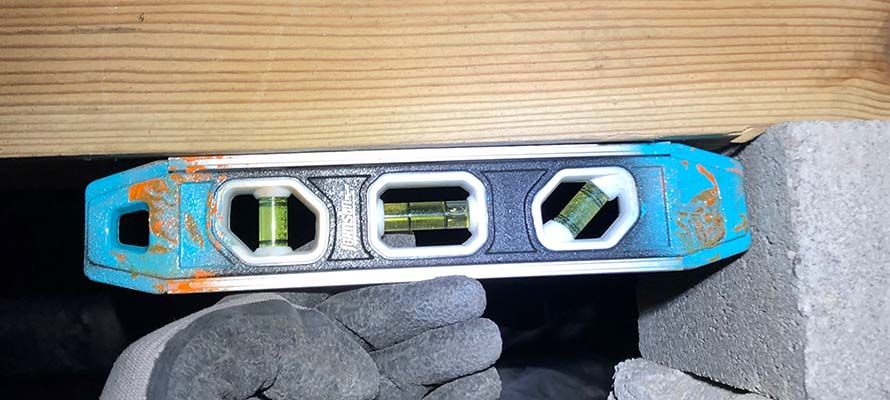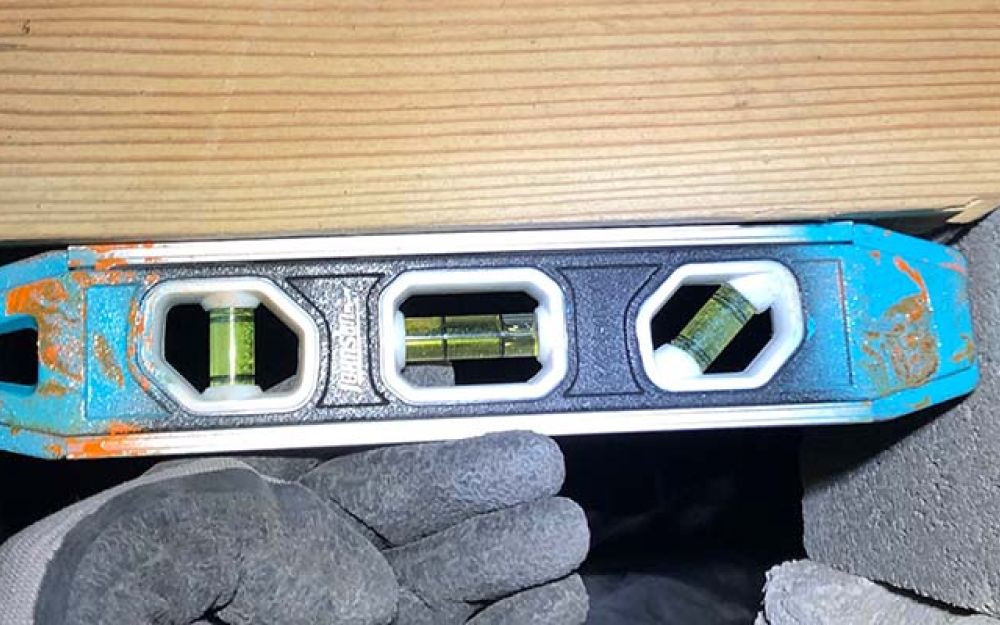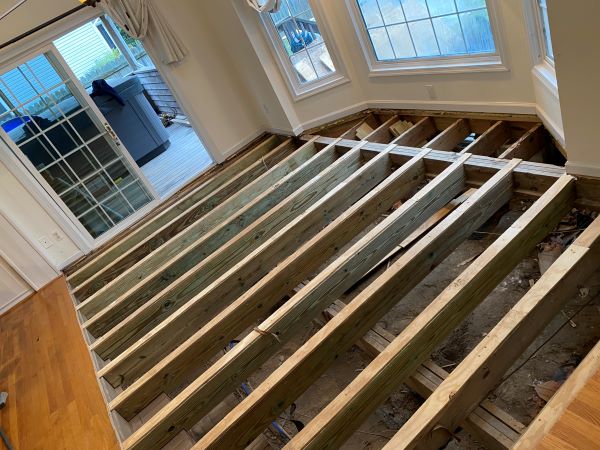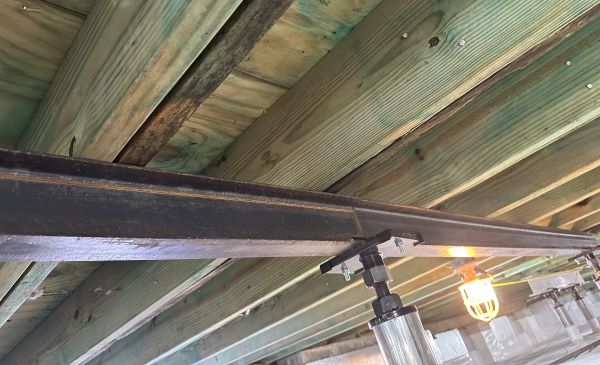The Dangers of Sagging Floor Joists and How to Get Them Fixed Fast



If walking around your house feels like you’re bobbing up and down on a boat in the ocean, then it could be a sign that you’ve got sagging floor joists. Uneven floors are not only harsh on the eyes, but they’re a hazard to the home.
Sagging floors can indicate there’s damaged wood under your flooring, that one of your supports is deteriorating, or that there are problems with the foundations. Here are some other signs that you’ve got issues with your surface and how to fix sagging floor joists.
For professional floor joist repair services in the greater Hampton Roads, VA / NC region, learn more about BAY Crawl Space & Foundation Repair at our Home Page, About Us Page, or Request A Quote Page.
What Are Floor Joists?
Floor joists provide additional support to the flooring above it. They’re usually made of stronger wood such as Douglas Fir, Eastern White Pine, and (most commonly) Southern Yellow Pine.
They’re generally placed under the subfloor to allow access for wires and plumbing pipes. Floor joists must be level with the subfloor and foundation in order to provide the best support for the house.

What Are the Signs of Sagging Floor Joists?
It might seem obvious to spot an uneven floor, but there are other things to look out for. Some of the common indicators that you have sagging floor joists include:
Cracks on the Walls Inside the House
Sagging floor joists can also cause issues for your walls. Look out for cracks or fissures in the corners and joints.
Window and Door Problems
All of your windows and doors should fit perfectly inside your house. But it’s a different story when you have a sagging floor. They will either become too loose that it feels like they’ll rip off the walls or too tight that it takes more effort to open and close them.
Lack of Support
Beams in older homes were initially spaced further apart. Thankfully, today’s building codes have changed the spacing requirements. But if you’re in an older house, then the larger spans between the beams and the long floor joists may be the reason why your floor is sagging.
Sloping Floors
Some homes have floors that are very uneven. Often times this is caused by long spans, moisture, and settlement. If the floors in a home are not even, there is a good chance the floor joists are not supporting as they should.
Bouncy Floors
If you hear rattling every time you walk around a corner, the floors are probably getting by with minimal support. Bouncy floors cause furniture and other items to shake and vibrate due to inadequate support. If the floors do not feel firm, that’s a sign the floor joists need more support.
How to Inspect Your Home When Your Floors Are Sagging
If you want to confirm your suspicions about your uneven floor, there are ways that you can investigate your floor joists. But you do need to know what you’re looking out for.
The easiest way to check is if you have a basement. Take a good look at the basement support beams and posts that meet the floor.
Crawl spaces are not as easy to inspect. You will want to wear protective clothing like a Tyvek suit, gloves, a headlight (or flashlight) and potentially a respirator.
While you’re in the basement or crawlspace, if you notice that it’s continuously damp, then it could be a hive for insects that love to destroy floor joists. Powderpost Beetles can turn them into Swiss cheese by chewing through them. Carpenter Ants and Termites can also do plenty of damage to floor joists, particularly in the Spring.
If you are able to inspect the floor joists directly, you’ll want to see if they have fungal growth, spans greater than 10′, proper support by the beams and piers, or excessive moisture.
What Causes Sagging Floor Joists in Older Homes?
Wood tends to rot when it’s exposed to humid air and moist dirt. This can cause the joists to weaken and shift the support it’s supposed to give to the subfloor. It’s essential for you to know how your house was built so that you understand how you’re going to repair the sagging floor joists.
Why You Should Fix Sagging Floor Joists
An uneven floor can often be just the beginning of problems to occur with your home. If the reason for the issues with your floor joists is a wet crawl space, then you can expect more troubles to come.
When a crawl space isn’t sealed off properly and protected from moisture, it can damage the floor joists, rot the wood, attract insects and pests, and grow mold and bacteria.
If you’re looking to sell your house, then it will hit your hip pocket harder. Realtors must disclose to potential buyers that the foundation of a home is weak, damaged, or has sagging floors. This can potentially drop the value of your home by up to 20% if you’re looking to sell.
How to Fix Sagging Floor Joists
There are several ways to fix sagging floor joists. It will depend on the condition of the beams and the surrounding environment. Some of the most common methods of repairing sagging floor joists include:
Joist Sistering
Sistering is when an identical piece of wood gets fastened to the floor joist. This provides extra support and is better secured compared to ‘scabbing’, which can be inadequate.
Beam Replacement
One of the biggest issues with structural damage is that the conditions can affect all of the wooden framing under the house. Any structural beams that are damaged or sagging should be replaced or supported.
Structural Jacks & Beams
Long joist spans and poorly planned structural layouts cause more sagging floor joists than anything. If the beams are spaced too far apart, the long floor joists are probably stressed and bowing under the weight of the home and gravity.
A crawl space repair professional, like Bay, can install strong foundations, steel structural jacks, and new custom beams to permanently stabilize the floors and walls in almost any area.

Preventive Measures to Protect Floor Joists
Prevent sagging floors and potential collapse by following these steps to protect your floor joists:
Ensure Proper Ventilation
Make sure your crawl space or basement has good airflow. This will reduce humidity and prevent moisture from damaging the wood.
Install Vapor Barriers
A vapor barrier helps keep moisture away from your floor joists, preventing wood rot and weakening.
Use Treated Wood
Choose wood that’s resistant to moisture, insects, and decay for your floor joists. This will help prevent sagging floors.
Regular Inspections
Inspect your floor joists routinely for any signs of damage or issues. Catching problems early can prevent more significant issues like floor shakes when walking.
The Impact of Humidity and Moisture on Floor Joists
Humidity and moisture can cause severe problems for floor joists. When exposed to damp conditions, wood can rot and become weak. This can lead to sagging floors and even floor collapse. Also, damp environments attract pests like termites and carpenter ants that can damage floor joists. Keep your crawl space and basement dry and well-ventilated to prevent these issues.
The Role of Proper Insulation in Preventing Floor Joist Issues
Insulating your crawl space or basement can help prevent floor joist problems. Proper insulation keeps the area dry and reduces humidity, preventing wood rot and weakening. Plus, insulation can help keep pests away and reduce energy costs. Make sure to choose the suitable insulation material and install it correctly to protect your floor joists and prevent issues like floor shakes when walking.
How to Properly Maintain Your Floor Joists
Proper maintenance is essential to avoid sagging floors and potential collapse. Follow these steps to keep your floor joists in top shape:
Keep the Area Dry
Ensure your crawl space or basement has good ventilation and is free from water leaks or standing water.
Pest Control
Keep an eye out for pests like termites and carpenter ants. If you spot any, contact a professional pest control service.
Repair Damage
If you notice any damage to your floor joists, address it at once. Fixing issues early can prevent more significant problems, like floor shakes when walking.
By following these tips, you can keep your floor joists in good condition and avoid sagging floors and potential collapse.
Who You Should Contact When You Have Sagging Floor Joists
It might seem odd for some homeowners to contact someone about the space underneath their house since it is “out of sight, out of mind.” However, if your sagging floors aren’t attended to quickly, then it can lead to more serious and expensive issues in the future.
With over 5000 homes serviced, at BAY, we are experts when it comes to fixing sagging floor joists. The team has over 200 years of combined trade experience and specializes in fixing crawl spaces and foundations for all types of homes. If you’re stressing about your flooring and foundations, get in touch with BAY for a free expert analysis and quote.
Voted #1 for Crawl Space & Foundation Repair
Our award-winning team of experts has hundreds of years of collective experience in crawl space and foundation repair. Here are a few reasons why our customers love us:
- Photos included with free inspections
- Flexible and customized options
- Discounts and financing available
- Excellent long-term warranties
- Great communication
#1 Rated For Fixing Sagging Floor Joists
Our reviews show our commitment to taking great care of our customers over the years. We pride ourselves on giving great customer experiences & delivering excellent value. Our experience & efficiency allow us to do more, for less.
- Google – 4.9 Rating with 800+ Reviews
- Angi – 4.9 Rating with 300+ Reviews
- Facebook – 5.0 Rating with 300+ Reviews
- HomeAdvisor – 4.9 Rating with 200+ Reviews
- Better Business Bureau – 4.9 Rating with 300+ Reviews

